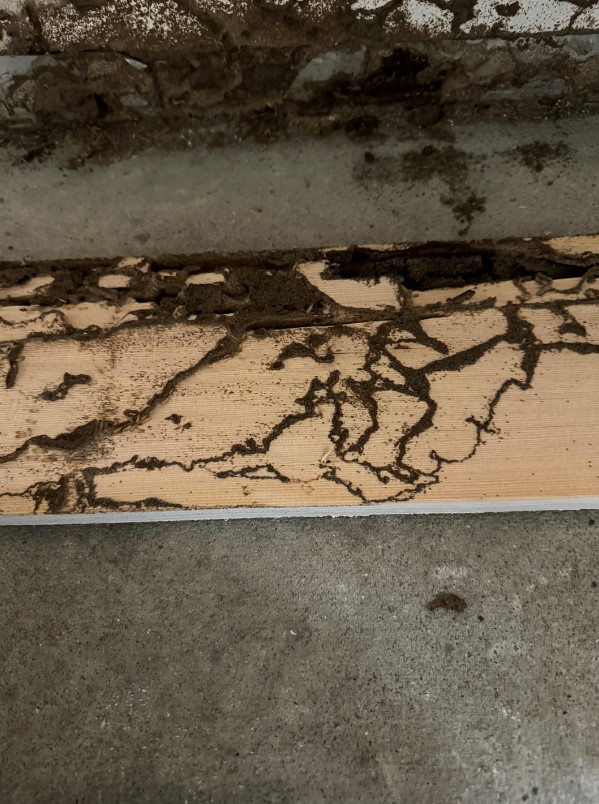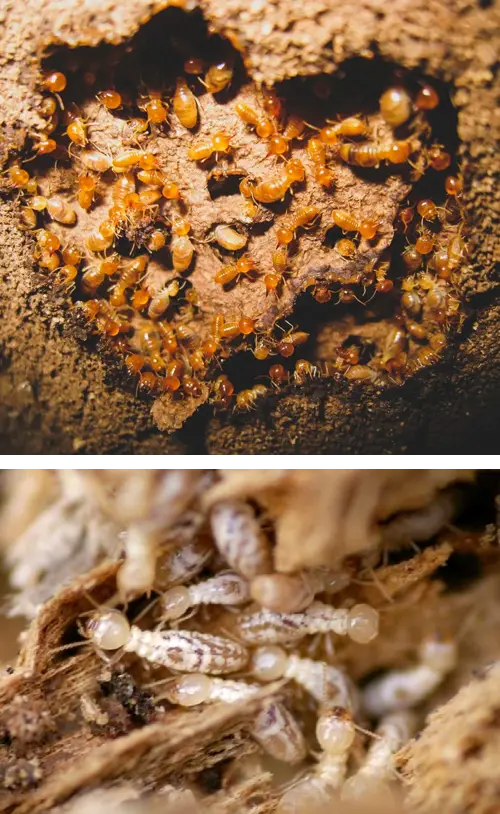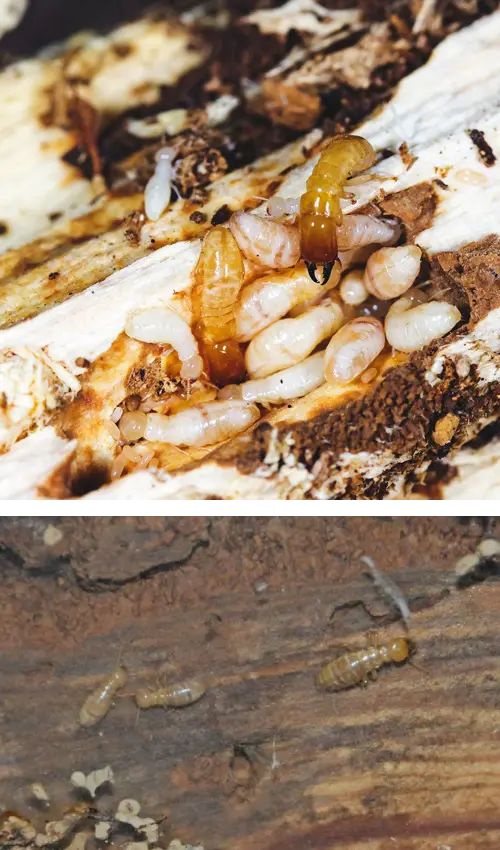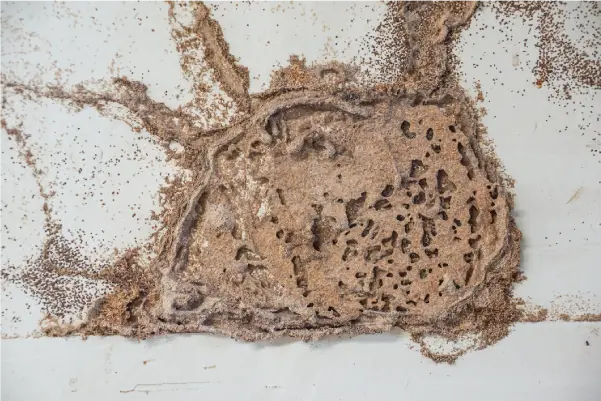Termites: Tiny Pests, Massive Damage!
They may be small, but termites can cause big problems—chewing through wood, drywall, and even flooring before you even realize they’re there! These silent destroyers work 24/7, turning your home or business into their personal buffet. By the time you spot the damage, they may have already been feasting for years!
Don’t let termites take a bite out of your property—call in the experts for fast, effective, and long-term protection before they turn your investment into sawdust!
Termite Control & Prevention
 Termites are truly one-of-a-kind insects, capable of surviving exclusively on cellulose, the organic compound found in wood. While they play an important role in breaking down decaying plant material in the wild, they can also become destructive invaders, causing severe structural damage to homes and businesses if left unchecked.
Termites are truly one-of-a-kind insects, capable of surviving exclusively on cellulose, the organic compound found in wood. While they play an important role in breaking down decaying plant material in the wild, they can also become destructive invaders, causing severe structural damage to homes and businesses if left unchecked.
Comprehensive Termite Inspection & Site Assessment
Our process begins with a thorough property inspection to:
- Identify active termite infestations and potential problem areas
- Locate infestation sites and wood-to-soil contact points, which increase termite risk
- Assess environmental factors that may be attracting termites to your property
Targeted Termite Control & Elimination
- Since subterranean termites nest underground, effective treatment focuses on eliminating them at the source
- We apply specialized treatments using trenching or sub-slab soil injection around the foundation perimeter
- This process creates a transferable barrier, ensuring that termites come into contact with the treatment and spread it throughout the colony, leading to complete elimination
Long-Term Termite Prevention & Protection
- Termites are a year-round threat, making ongoing prevention crucial
- Our preventative termite services not only eliminate current infestations but also safeguard your home against future attacks
At A&A Pest Control, our experienced technicians have the expertise and tools to fully eliminate termites and protect your home for the long haul. Contact us today for a professional termite inspection and long-term defense against these destructive pests!
Expert Termite Control Services
Termites are a serious threat across the United States, silently damaging homes and businesses from the inside out. Here in the Pacific Northwest, the two primary culprits are subterranean termites and dampwood termites.
Subterranean Termites
- These highly destructive pests nest underground and tunnel their way into structures, making professional treatment essential for long-term protection.
Dampwood Termites
- Typically infest moist, decaying wood and are less aggressive. In most cases, removing and replacing the damaged wood is enough to resolve the issue.
For long-term protection and peace of mind for your home or business, we encourage customers to consider installing a Termite Baiting System. Our team utilizes the TRELONA® Advance® Termite Baiting System, it is an effective, long-term solution for controlling and preventing termite infestations. It uses strategically placed bait stations around a property to attract and eliminate termite colonies.
These stations contain a highly palatable, slow-acting bait laced with novaluron, an insect growth regulator that disrupts the molting process of termites, ultimately leading to the colony’s collapse. Unlike traditional chemical barriers, TRELONA is minimally invasive and environmentally friendly, reducing risks to non-target organisms. Regular inspections and maintenance ensure that termites are continually monitored and controlled, making it a reliable option for long-term termite management.
Our comprehensive termite control solutions provide unmatched protection against subterranean termites, ensuring your home or business remains safe, sound, and termite-free. Contact us today for an expert inspection and customized treatment plan!
Book Your Inspection!
- Quarterly & Bi-Monthly Programs
- Target Pests: Ants, spiders and various other crawling insects
-
Service Includes:
- Exterior perimeter inspection and application for crawling insect control
- Removal of accessible wasp nests on the structure of your home
- Sweeping of spider webs followed by an overhead application for spider control
- Interior services as needed
- Quarterly & Bi-Monthly Programs
- Target Pests: Rats, mice, ants, spiders and various other crawling insects.
-
Service Includes:
- Exterior perimeter inspection and application for crawling insect control
- Removal of accessible wasp nests on the structure of your home
- Sweeping of spider webs followed by an overhead application for spider control
- Service exterior rodent bait stations and inspect for potential entry points
- Interior services as needed
- Quarterly & Bi-Monthly Programs.
- Target Pests: Rats & Mice.
-
Service Includes:
- Exterior perimeter inspection for potential entry points, nesting areas or food sources.
- Seal up identified entry points to prevent the rodents from accesses the interior of your home.
- Service exterior and interior rodent bait stations.
- Interior services as needed.
Termite Identification
While the United States is home to several termite species, Oregon and Washington primarily deals with two types: subterranean termites and dampwood termites. Both species play an important role in breaking down dead wood, helping to maintain a balanced ecosystem. However, when they invade homes or businesses, they can cause significant structural damage if left unchecked.
 Subterranean Termites
Subterranean Termites
Subterranean termites (Subs) are the most destructive species in Oregon and Washington, thriving underground where they retain the moisture needed for survival. They build mud shelter tubes to travel safely between their nest and food sources while staying protected from predators and dehydration.
How to Identify Subterranean Termites:
- Size: Small compared to dampwood termites, but colonies can contain up to 100,000 termites
- Coloration:
- Workers: Light cream-colored and soft-bodied
- Soldiers: Similar to workers but with larger heads and powerful mandibles
- Reproductives (Swarmers): Dark brown to black with two pairs of equal-length wings
- Signs of Infestation: Mud tubes on walls or foundations, hollow or damaged wood, or discarded wings near windows and doors
Behavior & Seasonal Activity:
- Subterranean termites are seasonal eaters, actively feeding during warmer months and becoming less active in colder weather
- They spread out in all directions looking for multiple food sources, so if you find signs of termite activity but no live termites, they may be feeding elsewhere
- Not seeing live termites doesn’t mean they’re gone—they may be dormant or simply eating in a different location
Why They Are Dangerous:
- Subterranean termites cause extensive damage quickly—a large colony can compromise a home’s structural integrity within months
- They rarely expose themselves, so most infestations are identified by damage rather than visible termites
If subterranean termites are found in your home or business, professional treatment is crucial to eliminate the colony and prevent further damage.
Dampwood Termites
 As their name suggests, dampwood termites thrive in moist or decaying wood. Unlike subterranean termites, they do not need soil contact to survive, but they require high moisture levels.
As their name suggests, dampwood termites thrive in moist or decaying wood. Unlike subterranean termites, they do not need soil contact to survive, but they require high moisture levels.
How to Identify Dampwood Termites:
- Size: Large—adults average ¾ inch in length, much bigger than subterranean termites
- Coloration: Cream-colored to light brown
- Body Structure: Unlike ants, termites have two distinct body segments (head and thorax), while ants have three (head, thorax, and abdomen)
- Signs of Infestation: Dampwood termites rarely leave their nest, but you may notice wood damage near moisture sources or swarms of flying termites in late summer
Where They Are Found:
- Leaky gutters, improperly sealed porches, rotting stumps, and wet landscape timbers
- Wood siding and framing that has been exposed to prolonged moisture
Why Dampwood Termites Are Less of a Threat:
- They only infest wood with constant moisture exposure—fixing the moisture issue will eliminate the colony naturally
- Unlike subterranean termites, they don’t form massive colonies and are easier to control
Swarming Behavior & Misidentification:
- Dampwood termites swarm at dusk in late summer, often causing concern for homeowners
- Many people mistake them for swarming ants, but there are key differences:
- Termites have two pairs of equal-length wings, while ants have one longer pair and one shorter pair
- Termites have two body segments, while ants have three
Since dampwood termites cannot survive without moisture, the best course of action is fixing the moisture problem and replacing the affected wood rather than chemical treatment.
Need Help Identifying Termites?
If you suspect termite activity, it’s best to act fast before extensive damage occurs. Send us pictures or schedule an inspection, and we will identify the type of termite and recommend the best course of action to protect your home or business!
Risks
The Hidden Dangers of Termite Infestations
Termites are silent destroyers, capable of causing extensive structural damage long before homeowners even realize they have a problem. While subterranean termites are the most destructive species in Oregon and Washington, especially in the coastal communities. Many local myths suggest they can’t survive here due to frequent rain, cold temperatures, or soil conditions—unfortunately, this is not true.
 Subterranean Termites: A Widespread Threat
Subterranean Termites: A Widespread Threat
- Subterranean termites are found throughout the Oregon and Washington regions and beyond, establishing large underground colonies that can span over 100 feet in all directions.
- A single acre of land can house multiple termite colonies, making infestations more common than many realize.
- They build protective mud tubes to travel between their underground nests and above-ground food sources, such as wooden structures. These mud tubes help them retain moisture and avoid predators but also serve as one of the first visible signs of an infestation.
How Subterranean Termites Damage Your Home or Business
- Worker termites travel through mud tubes to harvest cellulose from wood, bringing it back to the colony to sustain the entire population
- These feeding cycles can last days at a time, allowing them to weaken structural wood before detection
- Without intervention, termites can compromise the integrity of your home, leading to costly repairs
 Dampwood Termites: A Secondary Wood-Destroying Pest
Dampwood Termites: A Secondary Wood-Destroying Pest
- Unlike subterranean termites, dampwood termites only infest moisture-damaged wood
- The best solution is to remove and replace affected wood and fix water leaks or moisture issues to prevent reinfestation
- They are not considered a major structural threat, but their presence may indicate an underlying moisture problem that should be addressed
When to Be Concerned About Termite Swarms
- Dampwood termites typically swarm in between February and April, although environmental conditions such as warm temperatures (around 70°F) and recent rainfall can influence the timing.
- Swarms often occur during daylight hours on sunny, calm days after rain, when moisture conditions are ideal for survival outside the nest.usually at dusk on warm nights.
- Subterranean termite swarmers, on the other hand, are a sign of an active infestation. If you notice small, dark-colored flying termites around your home, take pictures and contact us immediately for an inspection.
Behavior of Termites During a Swarm
- Thousands of winged reproductive termites, known as alates, leave their mature colonies and take flight
- Alates are not strong fliers and are often carried by the wind
- When alates land, they shed their wings and begin searching for mates to form new colonies, making themselves confortable in your home or business
- Swarming termites are often seen around windows, doors, or light sources, as they are attracted to light
Not Sure What You’re Seeing? We Can Help!
If you spot termite swarmers, mud tubes, or damaged wood, you do not need to guess—send us pictures or call our office for expert identification. Our team is happy to assess your situation and provide the best course of action to protect your home from costly termite damage.
Effective Termite Control Methods
Subterranean termite infestations vary from home to home, meaning no one-size-fits-all treatment exists. The extent of the infestation, structural design, and surrounding environment all play a role in determining the best treatment approach.
Because subterranean termites nest underground, traditional surface treatments are not effective—the focus must be on treating the soil beneath your structure. By establishing a chemical barrier, we can effectively block termites from entering your home and eliminate the colony.
Comprehensive Termite Treatment Options Include:
Exterior Perimeter and Targeted Interior Structural Termite Treatment: This is our most recommended treatment using industry leading termite control products.
- Foundation Treatment: A full exterior perimeter treatment is applied where soil meets the foundation using one of two methods:
- Trenching & Treatment: A shallow trench (2–4 inches wide and deep) is dug, treated, and refilled
- Soil Injection: In some areas, we may inject the treatment directly into the soil using specialized equipment
- The best method is determined based on your landscaping, soil type, and foundation design
Treatment of Cement Slab Contact Areas: In areas where a cement slab meets the foundation, treatment must reach the soil beneath the slab:
- We drill small dime-sized holes 2–4 inches from the foundation, spaced every 18 inches
- The treatment is injected beneath the slab to reach the termite colony
- Holes are sealed and patched after treatment. (Note: Color matching is not provided, but we can discuss alternative methods if aesthetics are a concern.)
Treatment of Wall Voids & Wood Structures: If active termite activity is visible inside your home, we may apply localized treatments:
- Injecting infested wood members for direct colony elimination
- Foaming treatments in wall voids or wooden structures to expand coverage
- Drilling & soil injections for termites entering through interior slabs
- Surface applications on exposed wood when necessary
Each infestation is unique, and our technicians will develop a custom treatment plan based on your home’s specific needs. Additionally A&A Pest Control offers a 1-Year Warranty for treated areas to offer peace of mind.
Termite Prevention Tips
Protecting your home or business from subterranean termites begins with proactive prevention. While these pests can infest dry wood, moist conditions increase their activity and make your property more vulnerable. Taking a few simple steps can reduce your risk of infestation and help catch problems before they become costly.
 Manage Moisture Around Your Home
Manage Moisture Around Your Home
- Ensure gutters and downspouts direct water away from your foundation to prevent excessive moisture buildup
- Repair leaks from pipes, faucets, and irrigation systems that could create damp conditions near your home
- Avoid direct wood-to-soil contact by keeping wooden structures elevated off the ground and properly sealed
Stay Alert for Signs of Termites
- Watch for mud tubes along foundation walls or exterior surfaces—these are a major sign of subterranean termite activity
- Inspect wood for hollow spots or damage, especially near crawlspaces, basements, and exterior walls
- Look for discarded termite wings, especially in spring and summer, as swarmers indicate an active colony nearby
Act Quickly – Termites Won’t Go Away on Their Own
- If you suspect any termite activity, we recomment to not wait—the longer an infestation is left untreated, the more extensive the damage becomes
- Give our office a call for a professional inspection—our experts will assess your situation and provide the best course of action to protect your home
By staying vigilant and addressing potential risk factors, you can greatly reduce the chance of a costly termite infestation. Contact us today for a termite inspection and long-term protection!

